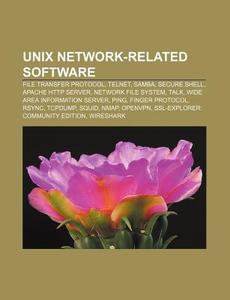
Unix network-related software
File Transfer Protocol, Telnet, Samba, Secure Shell, Apache Http Server, Network File System, Talk
- Editore:
Books LLC, Reference Series
- EAN:
9781156819135
- ISBN:
115681913X
- Pagine:
- 60
- Formato:
- Paperback
- Lingua:
- Inglese
Descrizione Unix network-related software
Source: Wikipedia. Pages: 57. Chapters: File Transfer Protocol, Telnet, Samba, Secure Shell, Apache HTTP Server, Network File System, Talk, Wide area information server, Ping, Finger protocol, Rsync, Tcpdump, Squid, Nmap, OpenVPN, SSL-Explorer: Community Edition, Wireshark, Metasploit Project, Rapid7, Netcat, Netstat, Pcap, Ifconfig, Polipo, Postfix, Ngrep, Ettercap, Inetd, NIS+, Slirp, Tinyproxy, Ssh-keygen, Network Security Toolkit, Snort, UT-VPN, TCP Wrapper, Point-to-Point Protocol daemon, Traffic Server, DansGuardian, Rlogin, Ntfsprogs, Nslookup, Paping, Network Information Service, Authbind, Tcpkill, Packetsquare, Portmap, Pound, Ziproxy, Lsh, TCP Gender Changer, Stunnel, Security Administrator Tool for Analyzing Networks, OFTP, Spamd, Berkeley Automounter, Remote Shell, SuEXEC, Ntop, Autossh, Sharity, Ttcp, Grsync, Thresh, Network Kanji Filter, Reverse telnet, Hping, WarVOX, CVSup, Dhcpd, Iftop, WWWOFFLE, Route, Stone, SSLBridge, University Toolkit, R-tools, Rcp, Ucspi-tcp, Lorcon, YXORP, Balance, Remote Process Execution, Uux. Excerpt: File Transfer Protocol (FTP) is a standard network protocol used to transfer files from one host to another over a TCP-based network, such as the Internet. FTP is built on a client-server architecture and utilizes separate control and data connections between the client and server. FTP users may authenticate themselves using a clear-text sign-in protocol but can connect anonymously if the server is configured to allow it. The first FTP client applications were interactive command-line tools, implementing standard commands and syntax. Graphical user interface clients have since been developed for many of the popular desktop operating systems in use today. The original specification for the File Transfer Protocol was written by Abhay Bhushan and published as RFC 114 on 16 April 1971, before TCP and IP even existed. It was later replaced by RFC 765 (June 1980) and RFC 959 (October 1985), the current specification. Several proposed standards amend RFC 959, for example RFC 2228 (June 1997) proposes security extensions and RFC 2428 (September 1998) adds support for IPv6 and defines a new type of passive mode. The protocol is specified in RFC 959, which is summarized below. FTP operates on the application layer of the OSI model, and is used to transfer files using TCP/IP. In order to do this an FTP server needs to be running and waiting for incoming requests. The client computer is then able to communicate with the server on port 21. This connection, called the control connection, remains open for the duration of the session, with a second connection, called the data connection, either opened by the server from its port 20 to a negotiated client port (active mode) or opened by the client from an arbitrary port to a negotiated server port (passive mode) as required to transfer file data. The control connection is used for session administration (i.e., commands, identification, passwords) exchanged between the client and server using a telnet-like protocol. For example "RETR

